Kazakhstan, Uzbekistan and Kyrgyzstan, April and May 2023
I had planned a trip to Kazakhstan, Uzbekistan and Kyrgyzstan for April 2020, even going so far as to buy plane tickets in January of that year. But we all know what happened that year. The dreaded C-19 kicked in about March, my flights were quickly cancelled, and I was in effective quarantine for the next 2 or 3 years.
One more try in January 2023, and I re-booked the flights again for April. Luckily this time Maggie was convinced to join me for this trip, and we would go on to Canada later. I would go to Almaty from Sydney and she from Winnipeg, hopefully to meet there at a similar time. Packed up, apartment in shut-down, and car with a car-sitter, I was on a plane for Almaty via Seoul at 09:30 on 10 April. My flight schedule gave me a 23-hour stopover in Seoul, which I survived by exploring around the Incheon terminal and finding a place to sleep.
Kazakhstan
I was in Almaty airport on time at 21:40 on 11 April, and through passport control and immigration without incident. Maggie's flight would arrive at 23:30. I'd been worried about getting money (the 'Stans were said to not favour Mastercard) and getting ripped off by taxis, but there was a tourist information in the airport that was open all hours, and the guy there helped me through it all. Maggie also arrived on time, great to meet up after such long distances, and we were soon in a cab to the Hotel Tahar in Almaty. It had been a long trip from Sydney (and from Canada), and good to be finally at our destination, even though in the middle of the night. I'd been looking forward to Central Asia, and was quite pumped about spending the next 6 weeks exploring these exotic locales.
On our first full day, we got our bearings thanks to maps.me and set out to explore a few sites around Almaty. First was the Almaty Central Mosque, an impressive gold-domed exterior with a rather spartan interior. Then south a short distance to the sprawling Green Bazaar. It's one of these vast multi-level complexes, spilling out onto streets and neighbouring blocks, selling a vast array of goods from designer apparel to dried fruit to sewer pipes. Maggie mostly sat outside a while as I wandered the various departments.
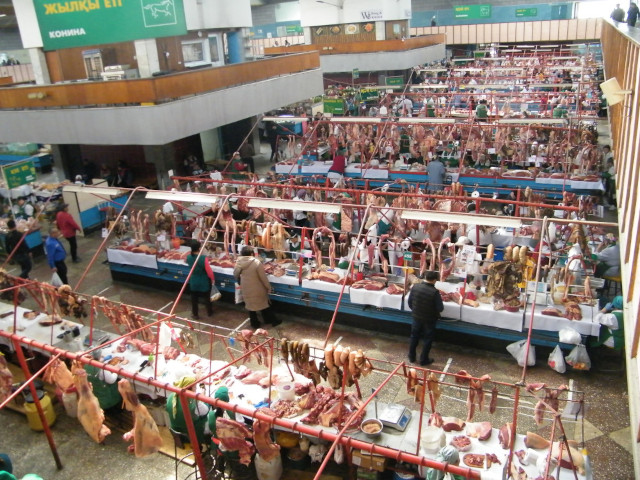
Meat Section, Green Bazaar
The huge meat section was probably the most distinctive, each subsection identified by images of the animals on display, from sheep to horses. We stopped at a local eatery for lunch of lagman noodles and boiled dumplings and coffee.

Lunch at Green Bazaar, lagman and mantis. Don't know if beef or horse.
From the market we went south to the Panfilov Park & War Memorial. The park itself is a pleasant grass wooded area with intersecting footpaths, giant big-eared squirrels and equally giant flocks of pigeons. The war memorial is a grimly impressive Soviet-style nod to Almaty soldiers who died defending WW2 Moscow.
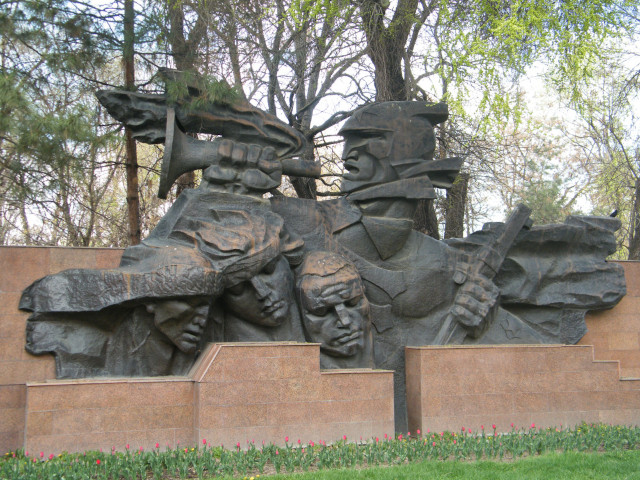
War Memorial Sculpture, Paniflov Park
In the park also is the very ornate Orthodox Zenkov Cathedral, one of the few survivors from Soviet times. It was built of wood with no nails, and has survived a number of earthquakes.
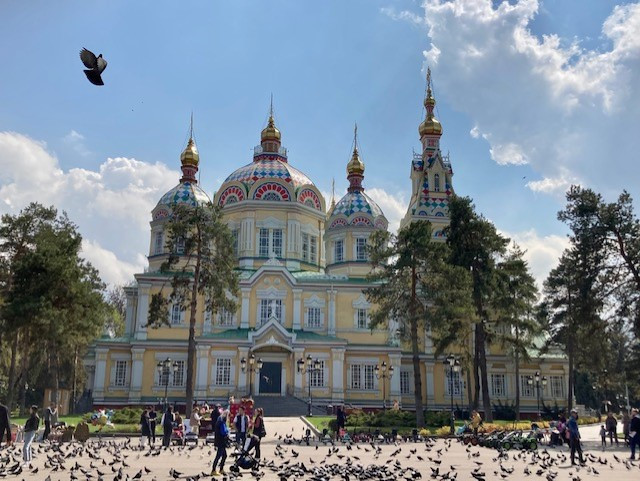
Zenkov Cathedral, Paniflov Park
We couldn't really be comfortable or plan much until we sorted out our onward transport possibilities. So we consulted with our hotel host and arranged to go together to the nearby Almaty-2 train station, where no-one would speak English, and sort out train transport in Kazakhstan. We ended up with:
1. Almaty-2 to Astana-new for 16/4, 13:28 to 17/4, 05:20.
2. Astana-old to Shymkent for 19/4, 09:20 to 20/4, 11:19.
3. Shymkent to Tashkent, Uzbekistan for 25/4, 05:23 to 10:28 arrival.
Most of the transport would be by train, generally a more comfortable option than buses or share taxis, and quite agreeable to Maggie. Now we could look at accommodation for these destinations.
Trains settled, we now could explore Almaty more. We familiarised ourselves with the metro system; it's relatively new and impressive, but not quite on the same scale as that of Moscow. We found the Kok Tobe gondola/cable car terminal and took the cable up to the hill of the same name. It had a nice view of the city and the distant very high and snowy Tien Shan Mountains, the obligatory Beatles statue on a bench with queues to take photos, and a sort of fun fair and a rather small, sad zoo. We couldn't really walk far. The hill was worth the ride up, but not a great attraction.
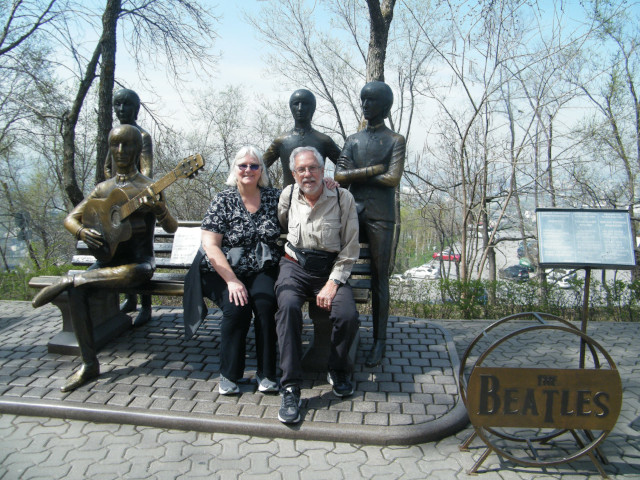
With the Beatles at Kok Tobe
One day, As Maggie would stay near home and spend time in Starbucks doing notes, etc. I took a bus up to Medeu in the mountains, the site of a large competition ice skating rink (in season), and at the current snow-line. I did a walk up and around the dam wall about 200m above. Started my walk with a gradual climb some distance up a road, to the bottom of a set of steps up to the dam. Beautiful views both up and down, hills, valleys and higher snow peaks. Plenty of snow around. Don't know why they call it a dam as it is dry and looks to have been for generations, and has trees growing in the "reservoir". After a rest, I decided to walk down into and around the dry reservoir. Interesting walk along paths and to the small river and through bush. Back up to the wall, I rested a bit and enjoyed the views and started back down. The whole walk was maybe a couple of hours, both tiring and invigorating. What a glorious day!

Upstream from Medeu Dam. I walked around the dry reservoir.
One day we decided to look around Republic Square and the Independence Monument area. The monument is a tall pedestal with a mythical hero-type guy standing atop a flying winged leopard and holding a falcon on his arm, all impossibly surreal and over-the-top. To the east is the Central State Museum, a large impressive looking building with garden surrounds undergoing some serious maintenance. The museum itself (T500 each) was over 4 floors in a richly designed and ornate interior. It had rich displays of palaeontology, artworks, and especially extensive ethnographic content. We must have been there close to 4 hours.
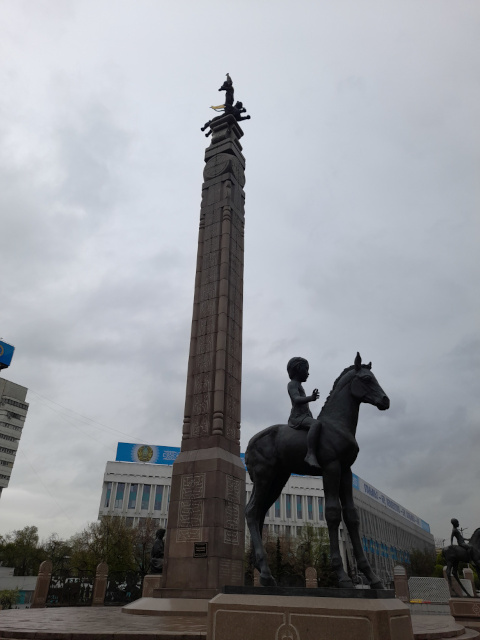
Independence Monument, Republic Square
We spent one evening absorbing the vibes of the Zhybek Zholy and Paniflov streets. This is a mainly pedestrian district, buskers around and people-watching and good atmosphere. Stopped at a small doner place and had a dinner of chicken kebabs, and later to a relatively up-scale restaurant for a drink.
It was a pleasant train trip to Astana, in the north of Kazakhstan. We had a small compartment to ourselves, very comfortable. The train proceeded through a bit of forest/park, suburbs and industrial area, and eventually into rolling hills and plains. It must have been raining because, for the first few hours at least, it was greener that expected. Here and there were herds of horses, cattle and sheep, sometimes tended by lone herdsmen. I found the scenery both invigorating and tranquil, and could sit with my phone music and gaze for hours. For the first while, the majestic snow-covered Tien Shan Mountains displayed to the left on the southern horizon. As we proceeded west and then north, the steppes gradually became drier and "rougher", mostly flat but with some hills.
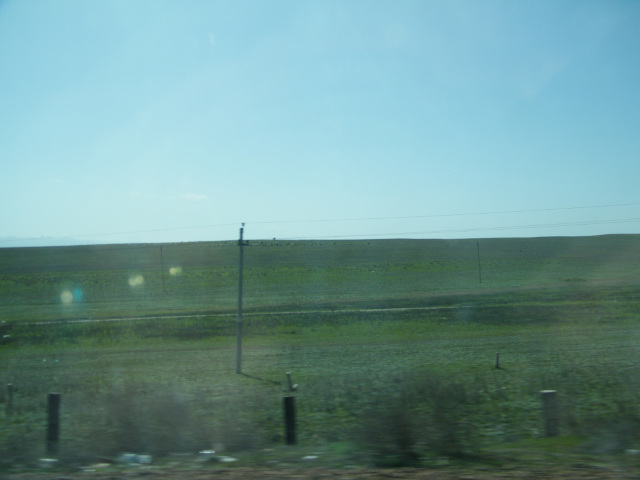
Kazakh Steppes from train, horseman on horizon.
I'd heard the weather in Astana would be unseasonably cold, but wasn't prepared for the shock of waking up to a view of snow dusting the ground and flurries in the air. What are we doing up here in this weather? As the train approached Astana New station, the weather only worsened. We exited the train sometime after 07:00 into blowing and drifting snow, struggled through the platforms into the large and nearly empty terminal and wondered what to do next. There were no commercial facilities there and no-one to talk to. Outside there was a near-blizzard, little traffic and no taxis.
Eventually a policeman found us a share-taxi with 2 other passengers for a high "storm" price. What ensued was a nightmare. The driver struggled through first this street and then the next, constantly following other vehicles, getting stopped and having to find other routes. People were shovelling snow and pushing vehicles everywhere. As we got farther from the station toward the city, traffic slightly improved but not much. It must have taken close to a couple of hours to get to our destination, many times wondering if we'd get there at all. We had to walk the last 100m or so to the hotel through deep snow carrying our luggage and getting wet shoes.
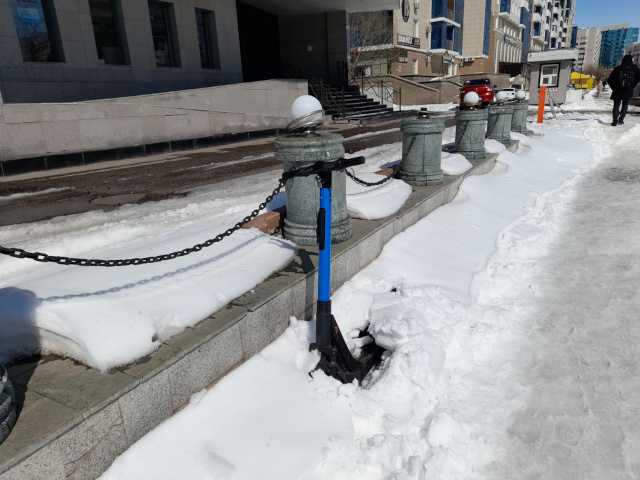
Half buried scooter, Astana
We only have a day or two in Astana, so tried to go out when the weather cleared in the afternoon. But there was still deep snow and treacherous walking/driving conditions. We didn't get far, only finding a restaurant for lunch and a store to get some groceries for later meals.
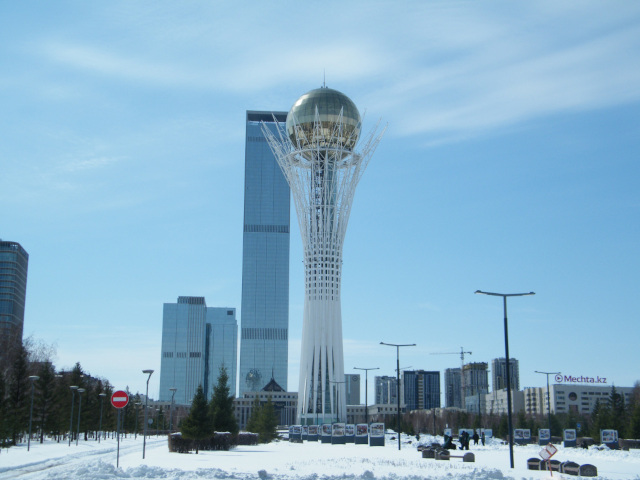
Bayterek Tower, Astana.
On our only full day in Astana, we tried to brave the treacherous streets and footpaths, and look around some of the main sites in the centre of the city. Astana is the recently-built new capital of Kazakhstan. As such, it is heavy on the fancy, gaudy architecture and impressive buildings. The Bayterek Tower is the main architectural/cultural icon of the city, symbolising the tree of life with the golden egg of Samruk atop. We could take an elevator nearly 100 metres up to the centre of the "egg" at the top. We enjoyed magnificent views in all directions. We could see to the edge of the city and beyond; it's striking how finite Astana is, it goes for relatively short distances to its edge, then a sharp boundary, and beyond is near-infinite flat featureless steppes. Looking straight down to the gardens below, the Islamic-inspired geometric designs of hedges and trees are remarkably beautiful.
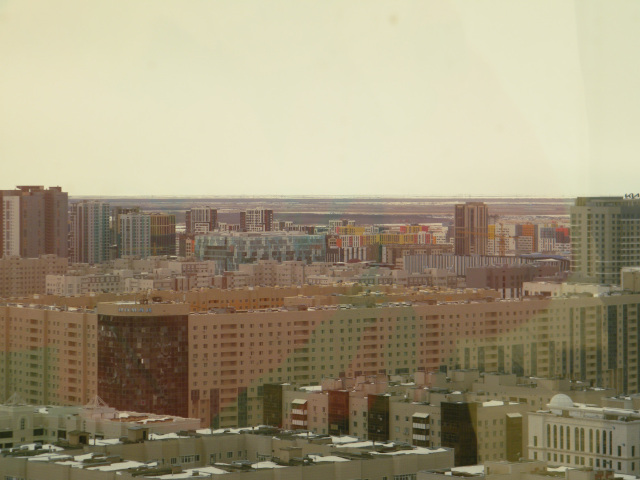
Astana from tower; note the finiteness of city.
Other sites included the arches of the immense curved government ministry buildings, the imposing Ak Orda Presidential Palace, more government buildings and the two golden conical buildings whose name escapes me, a fancy-curvy-shaped bluish building that looked something like a sports stadium. There were few people around except men in uniform and police cars.
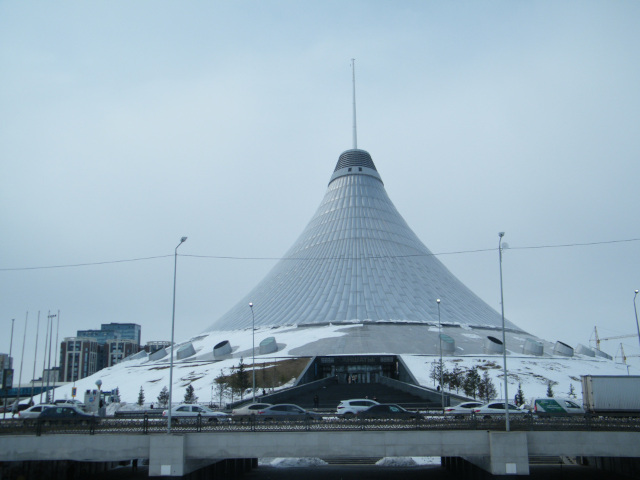
Khan Shatyr shopping complex, Astana.
Onward west was the park/concourse of Nurzhol Blvd, the snow-covered and uninspiring Park of Lovers, and the giant-tent-shaped Khan Shatyr shopping complex. The Khan Shatyr is distinctive-looking from the outside; inside it's basically a large high-end shopping complex. Several workers shovelled snow off paths, etc. and here and there we could see e-scooters for hire but mostly buried in snow.
It was a good day; having covered a lot of territory over several km, not sustaining serious injuries from the treacherous conditions, and seeing many of the main sites. It was ultimately tiring but well worth it.
The taxi to the train station on 19 April was much easier and more pleasant than the blizzard one a couple of days ago. Our train to Shymkent was older, and not so nice as, the previous one. Toilets were more grubby and, instead of the hot/cold electric water dispensers we had the old-style samovars. Still, it was comfortable enough for the very long 26-hour journey to Shymkent. We got into a 4-berth compartment with 2 other Kazakh guys. Neither spoke English, but they were nice enough and were offering us food etc. throughout. One of them was an ex-lawyer who was very friendly and interactive; he helped us a lot throughout. Maggie was having difficulty accessing her upper bunk, and he offered to go up there himself, and give her the lower bunk, very generous and considerate. Communication, as in much of the CAR, was by phone with Google Translate.
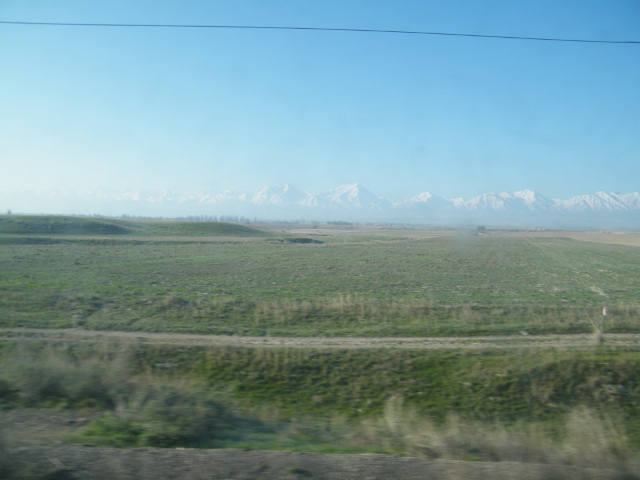
Near Taraz, Kazakhstan. Tien Shan mountains in distance.
The train proceeded south in clear weather, through snow-covered landscapes that didn't clear up until about Karaganda. From there we were treated to the endless monotony (though I still enjoyed staring mesmerised out the window) of the mostly flat, sometimes rolling, sometimes hilly, Kazakh steppes; brownish in the north and gradually turning greener as we proceeded south. Herds of horses were about, as well as sheep and cattle, sometimes being herded or watched by lone men or boys.
Arriving in the pre-booked Tourist Hotel in Shymkent, we were ushered into a nice room, but quickly discovered two fatal flaws. No-one spoke English, and there was no internet. Consequently, we could make no onward arrangements. We quickly had to abandon this hotel and frantically search for alternative digs. We found a backpackers' hostel, which had only dorm beds, but some English was spoken, and we could get wi-fi. It'll have to do; anyway, it was a charming place with good ambience and character. A bonus is that being a hostel, you can meet other travellers and get good insights on onward travel; we got valuable info on upcoming Uzbekistan and beyond.
There's not a lot of historical or cultural significance in Shymkent. We looked around the city, mainly the shopping plaza and some of the parks (the Abay Park was probably the most pleasant and interesting, with its statue of Ibrahim (Abai) Qunanbaiūly, a 19th century Kazakh poet/composer/philosopher, and war-memorial-related exhibits).
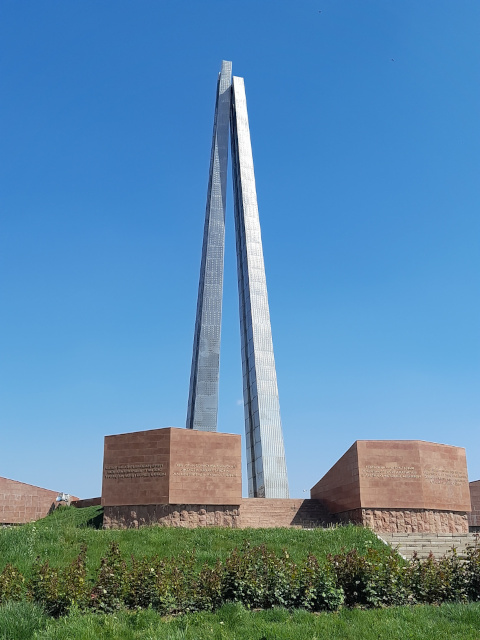
Abay War Memorial, Shymkent.
We were to go to the town Turkestan for one night, to see some of the cultural-historical monuments there, probably the main/only sites of that nature we'd see in Kazakh. We'd booked a hotel there for a night. But it would turn out to be a disaster, and ultimate failure.
We got to the bazaar about 11am, where the mini-buses for Turkestan leave. As we walked in, a "heavy" in a red jacket stopped us to offer his taxi to Turkistan, and wanted T10000. Thanks anyway; we continued on to the mini-buses, and got onto one and paid the fare. It got even more sour, when the Red-jacket gangster followed us, did a "stand-over" to the mini-bus guys, and forced us off the mini-bus, returning our fares. We couldn't even get on the next mini-bus. The gangster must have been the big capo and no-one could cross him. He took us back to the taxi and kept trying to get us to go for an extortionate price. Left with no choice, we finally had to abandon the trip, and get back on the bus to go back to Shym Hostel. So, we simply couldn't get to Turkistan for any reasonable price. That stuffed the whole day for us. Back at the hostel, I told the woman and others about our experiences, and they all said things like, "I'm shocked, never happened before" or "I didn't have any trouble", etc. Had to check back in to the hostel, and cancel the hotel in Turkestan.
The only compensation was that we both were coming down with a cold or something (that would persist for the rest of the trip) and we could now use the break. The next 2 or 3 days in Shymkent before moving on to Uzbekistan would be fairly low-key.
Uzbekistan
On 25 April, we were up early for a 05:20 train to Tashkent in Uzbekistan, taking about 6 hours. This would be our first border crossing on the trip, and would go as well as could be desired. Exit border formalities from Kazakhstan and entry to Uzbekistan were routine and problem-free. So, into another brand-new country, Whoopee! A taxi took us without problem to our Hostel Point in the north of the city, where we settled in OK. Tashkent seems a nice, pretty city, clean with many parks and cultural infrastructure. Transport, mainly by bus or metro, would prove easy and pleasant.
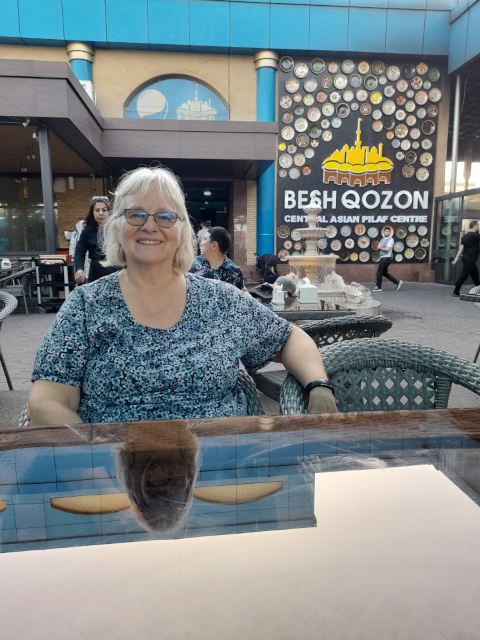
Maggie at the Besh Qozon Plov restaurant.
We had planned to travel to other parts of Uzbek, particularly Khiva, Bukhara and Samarkand in that order, and later on to Andijan and Kyrgyzstan. But we soon found problems. It seems that the trains book out fairly quickly, and we could not obtain our desired itinerary. With the help of our hostel host, and later the train station ticket office (with the help of friendly English-speaking bystanders), we were eventually able to score train tickets as such:
Tashkent to Samarkand, 29/4, 19:40 to 23:27.
Samarkand to Bukhara: 03/05 22.34, to 04/05 01:44.
Bukhara to Khiva: 06/05 00:25, to 06/05 06:33.
Khiva to Tashkent: 10/05 16:22, to 11/05 07:46.
Tashkent to Andijan: 12/05 06:18, to 12/05 13:05.
These trains would be generally at odd hours of the night and very inconvenient. Also, we could not visit the cities in the order that we would have liked. But couldn't be helped.
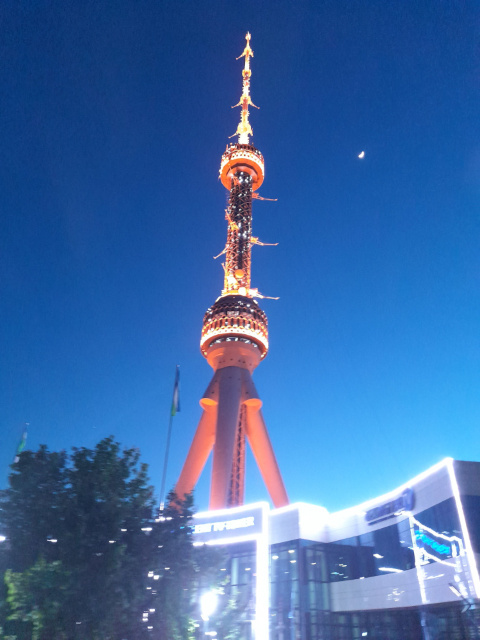
Tashkent TV Tower at night.
There were quite a number of good sites to see around Tashkent. In our time there we visited:
- The iconic Besh Qozon Plov restaurant for dinner, less than a km away from our hostel and in the shadow of the Tashkent TV Tower. The restaurant was big and busy and making the pilau rice dishes by the tubful. As good a plov as any you'd get, if you like that sort of thing.
- After dinner, but before sunset, we went up to the 6th floor of the TV tower for great views over the city. As the sun set, the city lights came on, including on the tower itself.
- The sprawling Chorsu Bazaar. It was a fairly typical market, partly under cover and partly spread out over a large outdoor area. Having become a bit "marketed-out", we looked around only briefly, and found a restaurant inside where we could get a couple of bowls of lagman (noodle) soup and tea. It all tasted OK, but Maggie was starting to say "enough lagmans and plovs for a while".
- The Hazrati Imam Complex, several madrassas, mosques, and other Islamic infrastructure in a small area in the "old city". The architecture was quite beautiful and impressive, and would give a taste of what we could expect in the other cities we would get to.
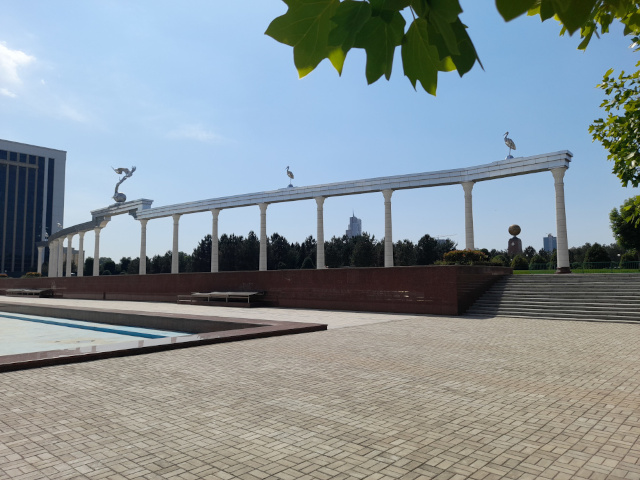
Independence Square, Tashkent.
- Independence Square (or Memorial Square, formerly Lenin Square, whew!). This square is large and green and wet from all the watering, with many workers doing insanely detailed cleaning and manicuring of all the walkways and plazas. There are many fountains, some starting to be filled, but not yet operational. A centrepiece is a row of 16 marble columns joined by a bridge, with sculptures of storks on top that symbolise peace. Farther back is a large globe on a tower, possibly the Independence Monument itself, and a statue of a woman holding a baby, the symbol of Motherland. Near the northern edge is the "memorial" section, with a memorial flame and a double row of wood columns and alcoves with the names of large numbers of war-dead.
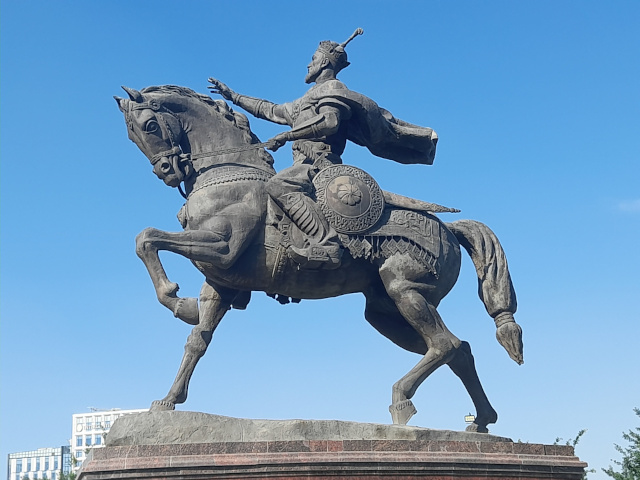
Timur Statue, Timur Square.
- Timur Square. The square is not large, but pretty and green and well laid out. At its centre is the 7-metre-high statue of Amir Timur on his horse. Timur, the 14'th century conqueror and ruler, called Tamerlane in the west, is of course the "hero" or icon of Uzbekistan, and is virtually worshipped here.
- The polygon-shaped State Museum of the Temurids. We spent an hour or so there looking at all the exhibits, over two floors, related to Timur and his times and associates. Lots of interesting artwork, military paraphernalia, models of Islamic structures, and artefacts. Intriguing were images and descriptions of the lineage of sultans and rulers, most of whom were murdered or died of arrows or in battle.
- The massive dominating Hotel Uzbekistan, where we could have a drink at the "Vienna Bar".
- The State Museum of the History of Uzbekistan. The main attraction is a linear narrative of history and ethnography from Neanderthal times through Bronze age, Buddhism, Timur times and up to the present, mildly interesting.- The Minor Mosque, a fairly modern but pretty mosque made mainly of white marble and ornately decorated.
Our original plan had been to see the Silk Road/Timur cities Khiva, Bukhara and Samarkand in that order, saving the "best" for the last. But our train restrictions dictated Samarkand first. On 29 April we were on the somewhat crowded, hot and sweaty evening train, for a 4-hour journey to arrive late at night. In Samarkand we were fortunately able to take a taxi and check into our hotel with minimal difficulty.
Samarkand is the most recognised of the three cities, and the biggest tourist magnet. But far from being the "best", we were relatively disappointed with it. We were based far from the centre, necessitating two tram trips to access. The city centre, with its array of sites, is quite spread out and requires a LOT of walking, sometimes putting Maggie into full-on protest mode. The sites are big and impressive but lack the ambience and intimacy of those in Bukhara and Khiva. We would spend about 4 days there, but the last two would be mainly around our hotel trying to rest and relax from all the walking.
Sites visited included:
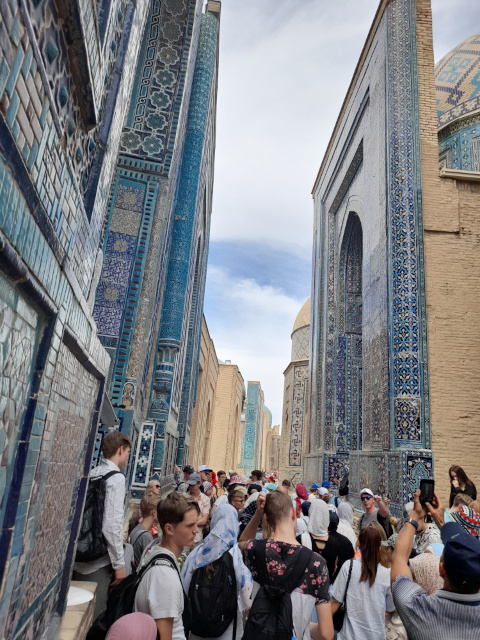
Shah I Zinda Complex, Samarkand.
- The Islamic cemetery (quite an interesting character to the place; many of the tombs are quite elaborate with large images of the occupants on the markers) and the Shah I Zinda Complex. The complex is mainly a series of mausolea of royal and noble people, I think from the Timur era, all very large and elaborate and artistic, with blue domes and minarets and a captivating atmosphere.
- The sprawling (I seem to use the same adjective for all the bazaars) Siyob Bazaar. Maggie sat this one out as well while I explored the various sections selling clothing, hardware, vegetables, meat/eggs, dried fruit/nuts/sweets, artistic-motif plates and bowls and restaurants.
- The nearby Bibi Khanym Mosque and adjacent Mausoleum. They were built by Timur for his wife of that name. The mosque was built in a hurry and not well, was largely ruined, and attempts are being made to restore it, sort of an ongoing WIP.

Registan, Samarkand, with its three madrassas.
- Samarkand's and Uzbekistan's most famous Unesco-heritage landmark, the Registan (meaning sandy or desert) complex, is the heart of the Timurid Dynasty. The Registan is basically a set of three madrassas (Islamic schools) set around a large courtyard. The Tilya-Kori Madrasah is the main and largest one, in the middle. Its walls are extensively gilt, giving it its name. To the left is Samarkand's oldest madrassa, the Ulugh Beg Madrasah. To the right is the Sher-Dor, or Tiger (from the wall motifs), Madrasah. All of the madrassas are very impressive with their size and complexity and the beauty of their motifs and decor. A couple of observations though about the Registan: 1. All very impressive, but once you've been in the courtyard a few minutes and taken your three photos, "now what?". 2. It seems a bit heretical that the exteriors are so stunning, even inspirational, but you look inside and it's all souvenir shops.
- The Timur Mausoleum. It is also called Gur-e-Amir, meaning “Tomb of the King” in Persian, and is the resting place of Timur (Tamerlane) and relatives. It is a beautiful complex with blue, white and turquoise tiles and terracotta bricks and a ribbed dome. Nearby is a statue of Timur sitting on a throne in the centre of a roundabout on the main road.
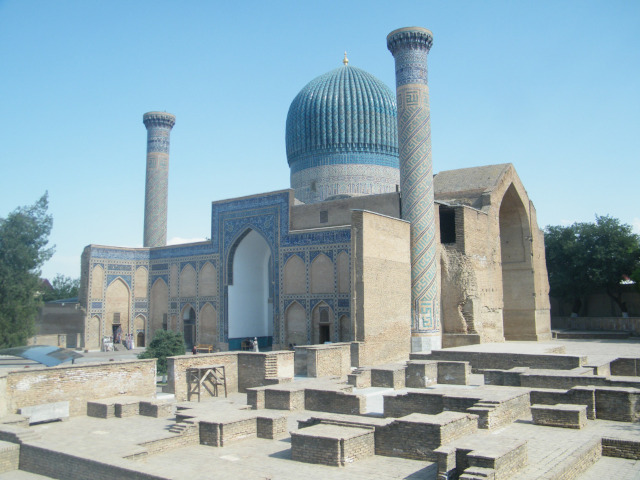
Gur-e-Amir Mausoleum, Samarkand.
As said, Samarkand was not our favourite place; too much walking and touristy and not the optimal level of ambience. Still, it was well worth it, and now "we've been there".
Next was Bukhara, a back-in-time discovery of stunning architectural wonders. This is likely the most unimproved and "unspoiled" of the 3 cities. But it fascinates with its beauty of design and construction. We were fortunate enough to get a hotel relatively close to the centre, and all the major sites were close together and in easy walking distance.
It didn't start off well though. We arrived in Bukhara in the middle of the night, had the usual taxi-tout hassles, and found that for unexplained reasons, we could not access our pre-booked hotel. The taxi guy eventually took us to another hotel (of his choosing?, was it a scam?) where we had to pay a premium price. Anyway, we were able to make the best of it and it turned out generally OK.
Amongst the major sites we saw, in no particular order:
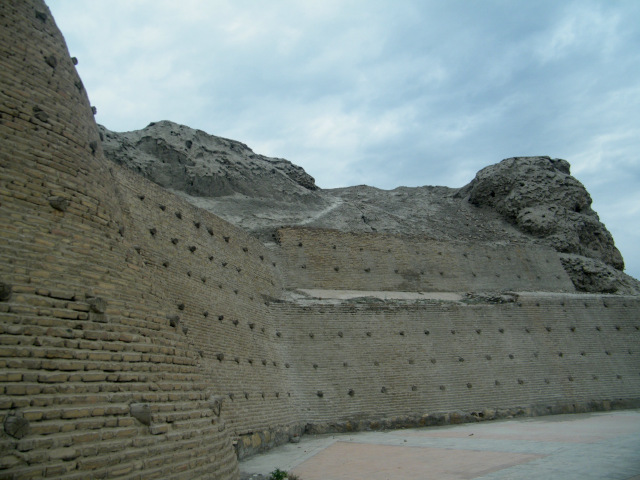
Portion of Ark Fortress wall, Bukhara.
- The Ark Fortress, a truly massive structure of sloped brick walls and rounded corners, parts partially restored, and parts in ruin. The interior was not as spectacular as the outside, mainly walkways, courtyards and rooms over a couple of levels, most of the rooms displaying museum exhibits of artefacts, military paraphernalia and nature dioramas. It was great in that there was a lot to see in the interior apart from the edifice itself.- There were several madrassas scattered around, some with great architectural beauty and significant historical interest, but as in Samarkand, sometimes filled with wall-to-wall souvenir and craft shops. As we wandered through, it was delightful to hear the tinking of metal smiths hard at work here and there.
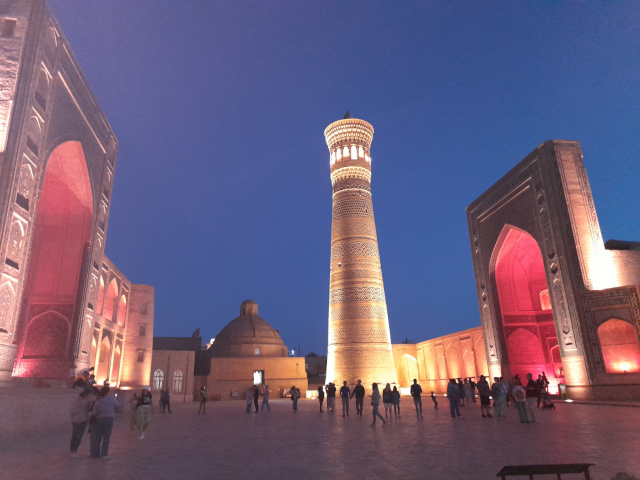
Poi Kalon at night, Bukhara.
- The Poi Kalon Ensemble is a large courtyard enclosing the huge and imposing 12th century Kalon Minaret, the large Kaylan Mosque, and a couple of madrassas. The minaret was so impressive to Genghis Khan that he spared it from destruction. The complex here is pretty much as impressive as the Samarkand Registan, but here, instead of a S50000 entry fee, you just walk straight in.
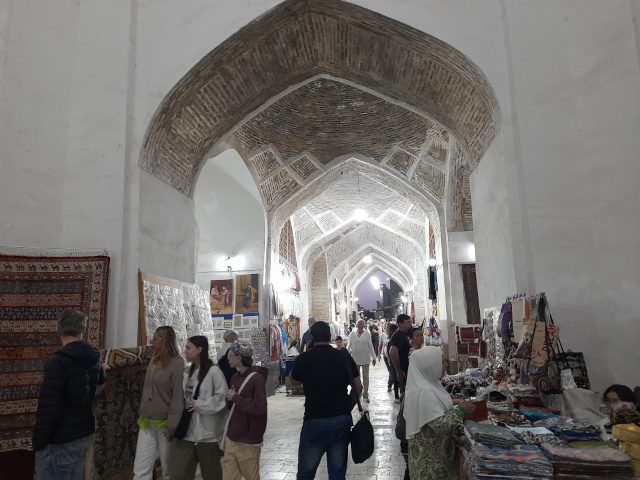
Bazaar at night, Bukhara.
- The Samanidov Park to the west. It's a pleasant park with a canal and lush grass and trees, ruined by a crass and garish kids' fun park. In the park was the Ismail Samani Mausoleum, from the Persian Samanid dynasty, a smallish pretty domed cube near a pond. At the time of Genghis Khan, it was covered in mud and therefore was not noticed and destroyed, only being recovered in 1934.
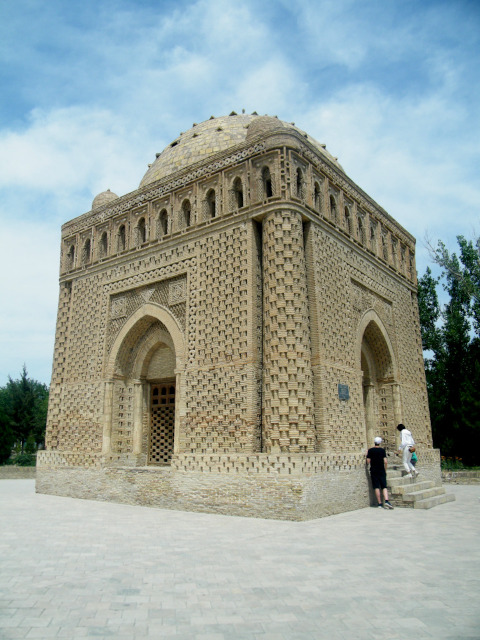
Ismail Samani Mausoleum, Bukhara.
- Through 'hoods to the east I found the little Chor Minor Madrassa, with its 4 pretty turquoise-domed minarets. I believe it was a gatehouse for a larger madrassa which didn't survive.
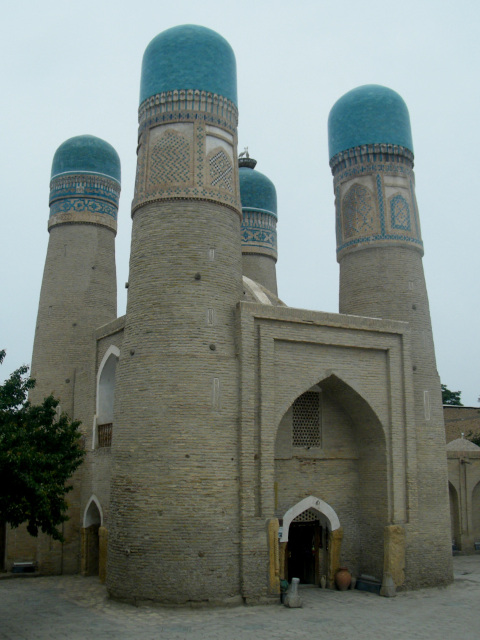
Chor Minor Madrassa, Bukhara.
We find that Samarkand has the name, but Bukhara has the character. Samarkand, impressive as it is, now appears somewhat soulless and sterile, and it can be hard work to get around to everything. Bukhara is much more dense and easy, and one can really immerse oneself in the place and just "absorb" it all. We would be in Bukhara only a couple of days, but thoroughly enjoyed this city. We LOVE this place.
Despite leaving Bukhara after midnight on 6 May, it was a fairly normal night train to Khiva, arriving there around 06:30. As it's a flat 2km or so walk from the train station to our hostel, we were able to avoid the taxi touts, and arrive to check-in within a half hour or so. The Ali Bek Hostel was a great place to say; we had our own room, the terrace afforded a magnificent view of the nearby Ichan Kala (Old City) walls, we could meet other travellers to compare notes, and they daily served up a magnificent breakfast - the best we've had on our trip.
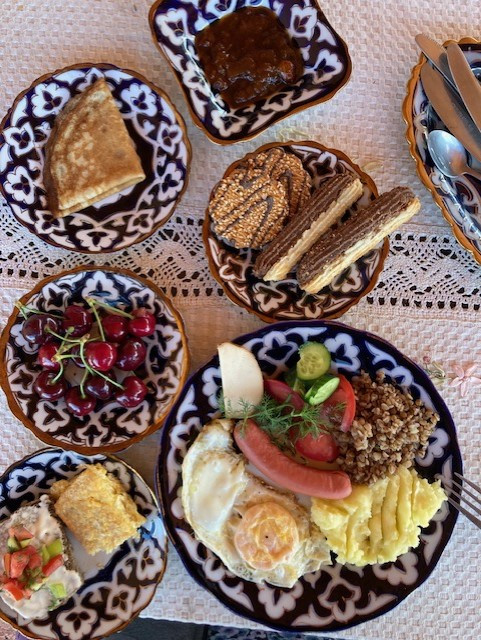
Amazing breakfast at Ali Bek Hostel.
We'd be here for around 4 days, plenty of time to explore and take in the main attractions. Main sites included:
- Ichan Kala's main east-west street, Palvon Kori, is an east-gate to west-gate throng of crowds, shops, restaurants, street performers, historical sites and souvenir stalls, A buzz at any time of day. This part of the city is ticketed entry, but the ticket allows access to many of the enclosed sites and museums therein.
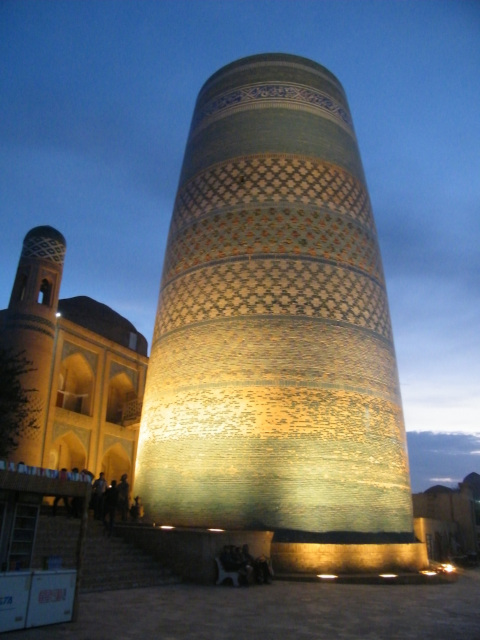
Kalta Minor Minaret at night, Khiva.
- The large stubby turquoise-tiled Kalta Minor Minaret, the icon of Khiva, was begun in 1851, intending to be the tallest minaret in Khiva, but unfinished when the Khan died. It's still one of the most impressive sites in the city, both by day or at night when it's lit up.
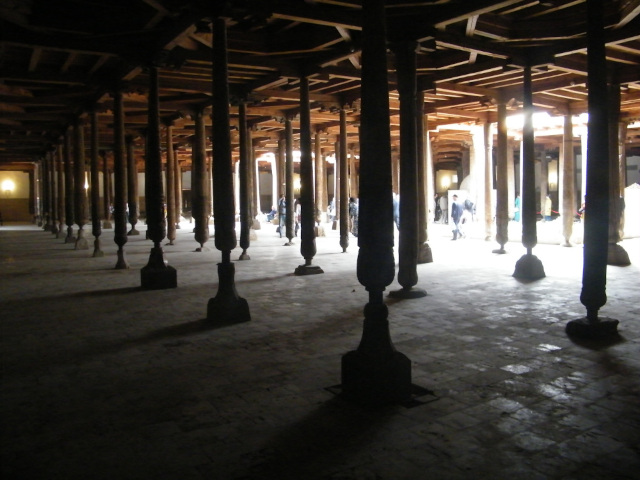
Juma Mosque with its carved wooden columns.
- The Juma Mosque has over 200 very ornately carved wooden columns and a wooden roof, some columns hundreds of years old, and light wells to give natural light.
- The Khuna Ark citadel, sort of a donjon within the city walls, was just inside the walls from where we were staying. Inside were more museum exhibits, a throne room, an area of ruins, and the steps up to the ark watchtower and ramparts. At the top, the views were good in a predictable sort of way.
- There are a vast number of little museums and madrassas almost everywhere you look, many free or included in the ticket price; we visited several of them, too many to remember or list individually. They included history, ethnography, crafts, a carpet and weaving centre, artworks and old rooms, wells, etc. I could write for hours about them, but it's just too much.
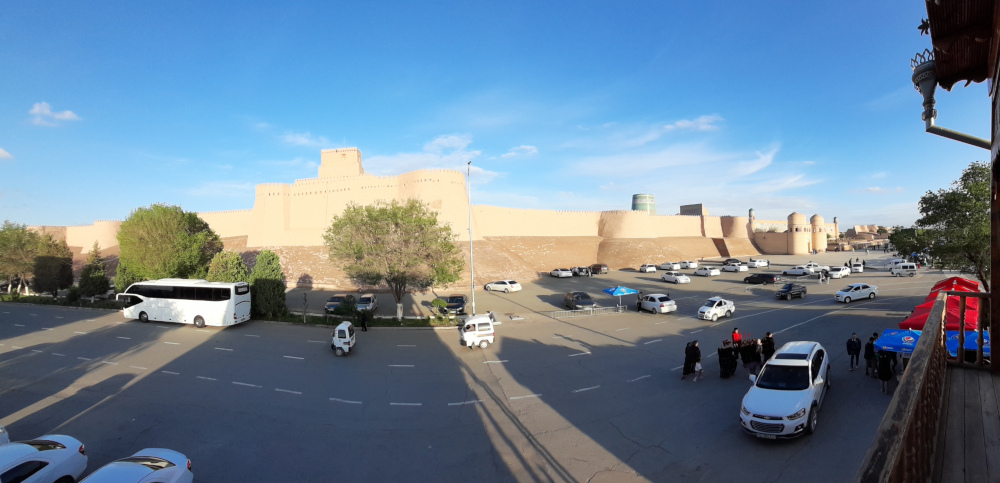
Ichan Kala wall from terrace of Ali Bek Hostel, Khiva.
- The palace was mildly interesting, mainly showing the Khan's harem, a large courtyard where on one side the Khan lived with his 4 wives and on the other side were his 40 concubines.
- At the north gate is a ticket seller who allows access to walk parts of the tops of the north, west and east walls. I went up there and walked around the walls as far as I could. There's moderate views and a pleasant enough walk, but nothing spectacular.
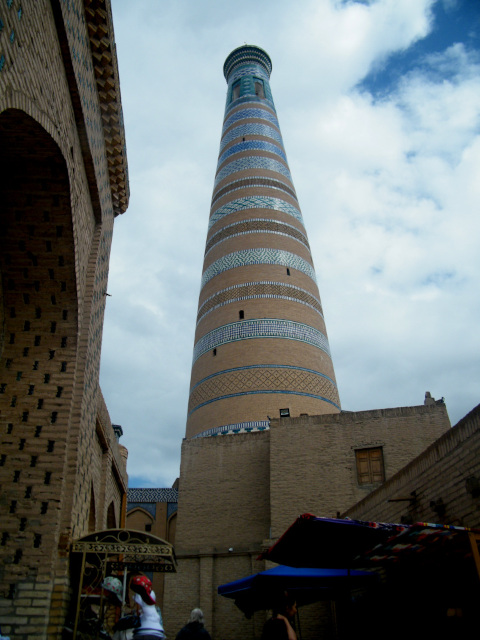
Islam Khodja minaret.
- The small Islam Khodja Madrasah has a relatively massive minaret. It's the tallest minaret in Khiva, and for an absurdly large price you can climb up to the top, which we didn't bother with.
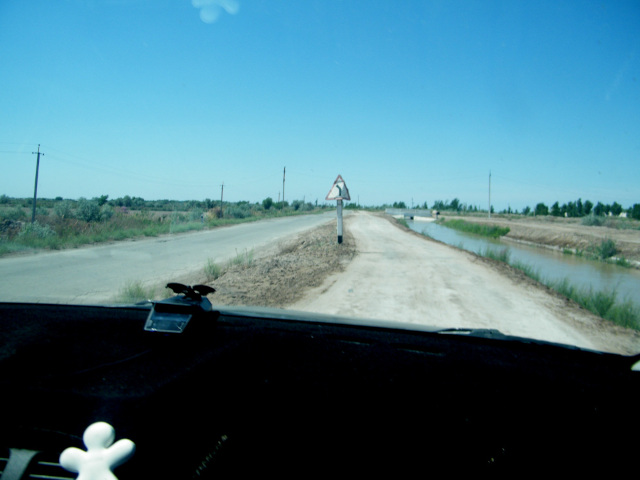
Sometimes the dirt is smoother than the pavement.
One day we allowed ourselves to be sold a day-tour to some of the old castle ruins a moderate drive to the north of Khiva, starting around 09:00. It was to be quite a hot day, about 29 deg. We drove for a couple of hours north-east through northern Khiva, semi-built-up districts to Urgench, across the large but not full Amu Darya River, through green countryside to the town Bushton, and onward through increasingly dry near-desert landscapes to our first destination Ayaz Kala. The roads became increasingly degraded as we went, full of cracked/crumpling pavement and potholes, even in some places forcing us to drive on the dirt to avoid the worst of the pavement.
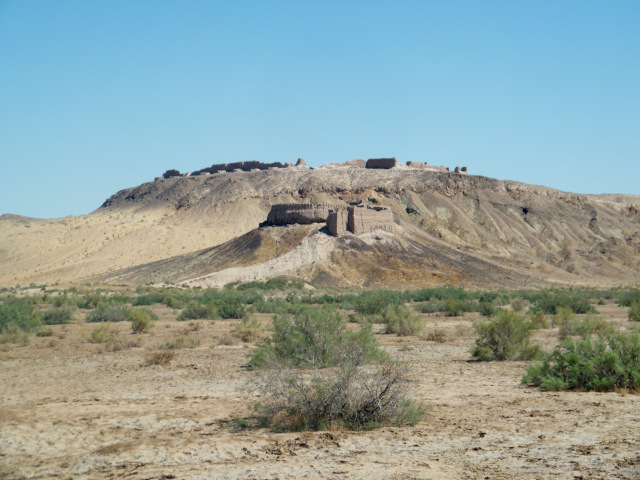
Ayaz Kala.
Ayaz Kala is a large ruins complex atop a couple of hills out in the middle of nowhere. Pedestrian access looked quite sandy and steep in places, so Maggie waited while I walked up to the castle ruin. The main kala complex is a large empty compound ringed by a much-degraded stone/dirt wall, with still some wall parts, arches and holes standing. It was quite a good, if slightly treacherous, walk to go all around the wall, mostly on top but sometimes inside. Great views both into the centre and to the surrounding dry flat countryside.
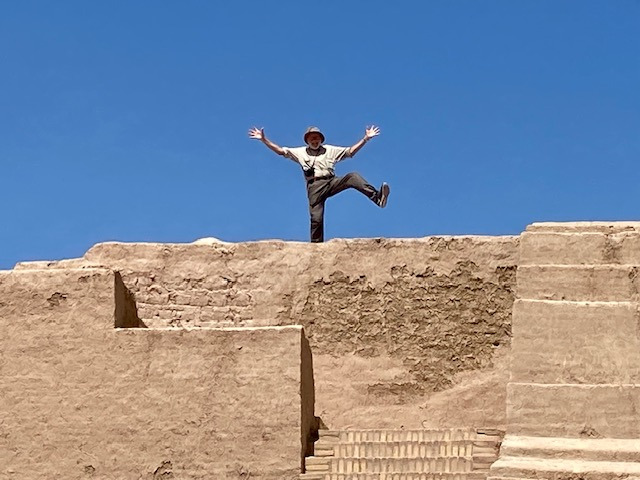
Atop Toprak Kala.
It was another half hour or so to the next place, the slightly smaller but more accessible Toprak Kala. It wasn't steep so Maggie could come up with me to explore it. Toprak is a compact castle, with some outlying walled portions, and a centre with many small walls and steps indicating residential complexes or something. We could scramble over most of it, and enjoy views of the interior constructions and the surrounds.
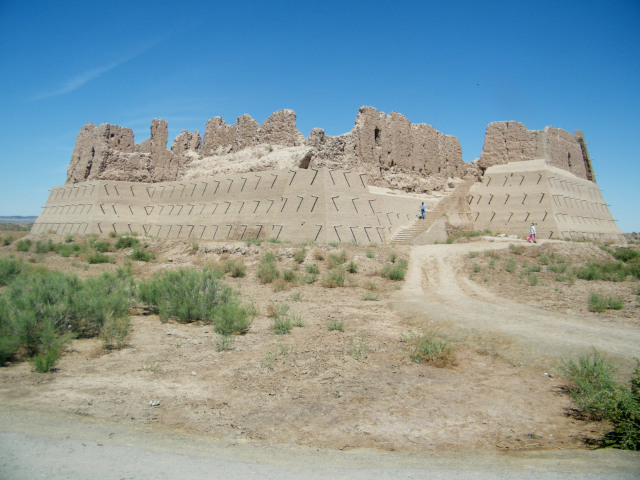
Kisil Kala.
The third castle, Kisil Kala, a short distance away, was again on a hill, and was the most compact of all. It had access by modern steps, so Maggie could easily come up. The walls were less "ruined" than the previous kalas, and were in quite pristine shape. The whole tour was about 6 hours, a most enjoyable trip.
On 10 May we were back at Khiva train station for our 16:22 train to Tashkent. It was a fairly routine night train trip; so far Maggie had been able to wrangle bottom bunks on each trip, so didn't have to struggle with climbing up to top bunks. Having not yet had a meal in a dining car, we thought we'd treat ourselves to a real elegant (think Orient Express) "dining car" experience. However, the dining car was not quite as expected, and definitely not fine dining. Hardly anyone was there to eat. The "attendant" reminded me of Cookie from the Beetle Bailey comics. We asked for a menu and got a blank stare. The guy indicated "wait" and went away a while. Then he reappeared with two plates of food, one a dish of stuffed capsicums and vegs, another a plate of egg, hamburger, rice, pasta and bourghil. As if to say "are these OK?" As these may be the only options, we indicated acceptance, ordered a beer and a Coke, and dug in. Not a great meal but edible. The pink-jacket TV train guy would not have been impressed.
We would be in Tashkent for only one full day before moving on to Andijan, in the south of Uzbekistan, and onward to Osh, Kytgyzstan. As such, we didn't do much except relax, prepare for the next leg, and go out again to the Besh Qozon Plov restaurant for another plov meal.
Despite some hassles and stressors, overall we found Uzbekistan to be a pleasant and accommodating place. This country had the most cultural and historical content of the three countries we visited. It was clean, safe and generally pretty, even beautiful; we loved it.
12 May had us again up early for our 06:18 train connection to Andijan. We got a fairly comfortable day-compartment with a lawyer guy who spoke some English and whom we could talk to, and made Andijan at 13:05.
That was the end of our train tickets; we'd now have to rely on share-taxis or mini-buses for most of the rest of the trip. In Andijan, we left the station and had to walk the best part of a km to get to the taxi/mashrutka area for the Dostyk border crossing, about 44 km away. The taxi place was the usual confusing and chaotic scene with aggressive touts, and it was hard to know which part to go to. We finally found what might have been a share taxi, convinced him with difficulty that we wanted to share, and were able to negotiate a fare to the border. We had to wait a while in the heat for 2 other passengers, slightly stressing Maggie, but she came through it OK. We were at the border maybe around 15:00. It was a relatively straightforward walk through the Uzbek exit and Kyrgyz entry.
Kyrgyzstan (Officially the Kyrgyz Republic)
The Kyrgyz side doesn't seem to get many Canucks, as they had to look up and discuss whether we're visa-free or not. In Kyrgyz, we were into the herd of aggressive taxi touts, and had to do hard negotiation to get a rip-off price into the city Osh. Traffic was horrendous but we eventually got to the Hostel Suleiman Too, just below the mountain of that name. Some hassles today, but as always, it's great to get through into a new country.
As we sort of overstayed our time in Uzbek with train schedules etc, we would not have as much time in Kyrgy. We were limited to our (mainly share-taxi) travelling time, a couple of days in Osh, 1-2 days in Arslanbob and 1 full day in Bishkek, before bussing on back to Almaty and our plane flight out.
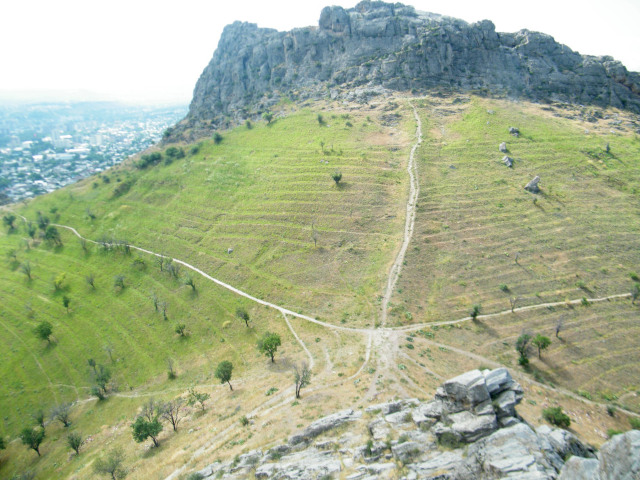
Some of the paths around Sulaiman Too, Osh.
Osh is a vibrant melting pot of cultures and ethnicities, combining Kyrgyz, Uzbbek and Tajik groups, and is generally considered the cultural capital of Kyrgyzstan (Bishkek is the political capital). There are many cultural/historic sites around the city, as well as the (mostly) natural sacred mountain Sulaiman Too.
In our 2 full days in Osh, we manged to see most of the attractions as well as rest/recuperate as required. Here are some of the visits and activities:
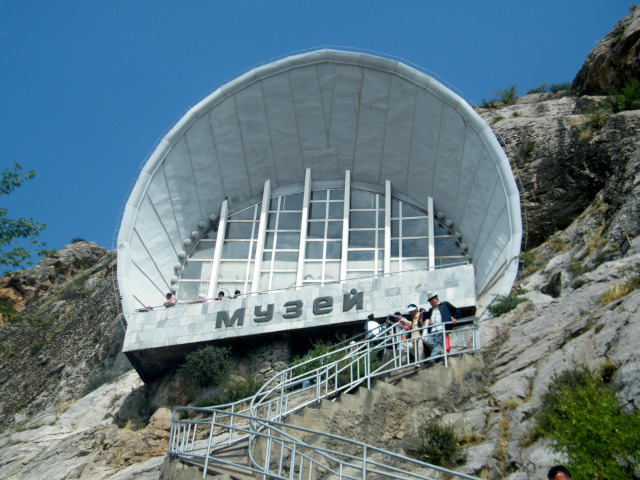
Soviet built hood of the National Museum Complex.
- I did some walks around and on the Sulaiman Too, that Silk Road travellers' beacon. It's five peaks and slopes contain a large assembly of ancient cult places and caves, to which sick people come in the hope to be cured. I went alone, as it was quite steep and Maggie would not have liked it. I went up paths through grassy slopes and explored some of the many paths that crossed the range. Up to one saddle, I continued around one of the smaller peaks and found my way to the top of it for magnificent views of the way I came up, the other peaks and the city below. Continuing around toward the south side, I encountered a couple of the sacred "healing" caves that were listed on the map. I had expected the caves to be full of religious icons or something, but they were bare except for graffiti. Down to a large formed path on the south side, I came to the Soviet built hood of the National Historical and Archaeological Museum Complex, which Maggie and I would later visit.
- To save Maggie's feet, we decided to get a Yandex (sort of a Russian Uber) to take us to the above museum. The museum was on two levels, the lower being exhibits from different historical eras, religions and peoples. Up along the stairs were nature exhibits and on the second level were miscellaneous exhibits and a panoramic view over the city. It was not a large museum but interesting enough.
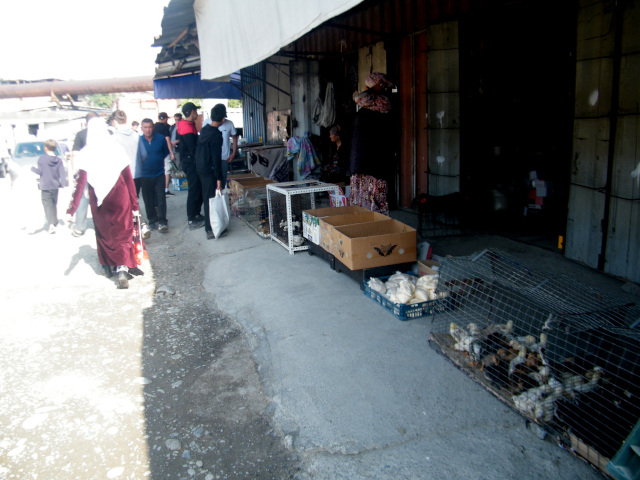
Chicken section, Jayma market, Osh.
- One morning I spent an hour or two looking around the busy Jayma Market. I got there around 09:00, just as the market people were bringing in goods and setting up. Sunday morning is meant to be a busy day, and it was; a buzz of activity. The market is VAST, covering a number of streets and alleys, and extending across the river and up the other bank. I wandered through fruit/vegetables, dry foods, shoes/clothing, meat, live poultry (some being peddled from car trunks), a very noisy and chaotic pigeon section, hardware and the odd eating place. It was great, really worthwhile, especially the live poultry.
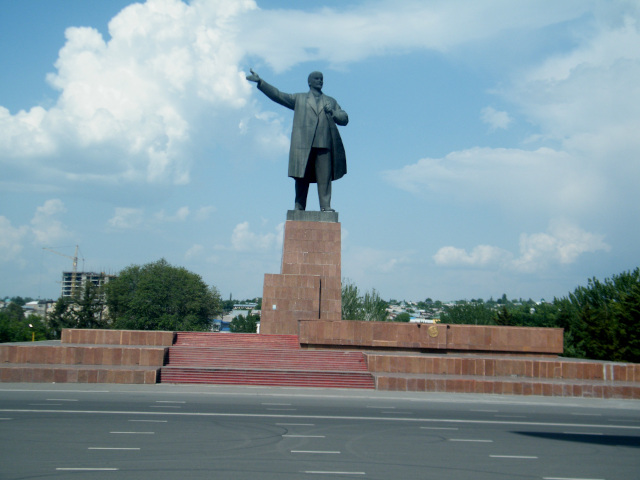
Lenin Statue, Osh.
- A giant Lenin statue stands (towers?) in the south of the city. The statue, at 25 metres high, is one of the largest in Central Asia. Nearby in a park is a series of memorials for personnel lost in the Great Patriotic War, Chernobyl, and the rioting in 2010.
Our next destination, the village Arslanbob, located in the province of Jalal-Abad at 1700 meters above sea level, is home to the world's largest walnut forest, and is said to be the origin of walnuts and the "Walnut Capital" of the world. We took a share-taxi to get there, leaving the Osh bus station about 07:00, passing through the regional centre Jalal Abad, and into Osh about 11:00. It was a beautiful trip up to Arslanbob, passing through bucolic farmland, distant mountains on the horizon, scenic river valleys and several stops on the road to navigate around herds of cattle, sheep or goats.
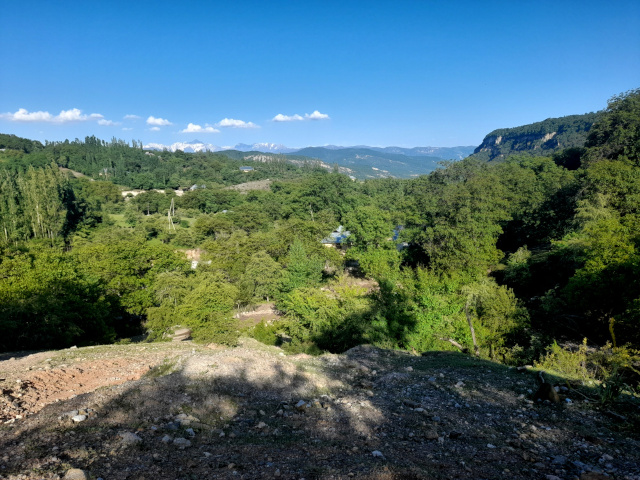
View over Arslanbob, Kyrgyzstan.
In Arslanbob, we had booked the Friendship Guest House some distance outside of town, and were to meet the owner for a pick-up. We found the Community Based Tourism office and guy, who gently berated us for not going with a CBT homestay (maybe next time), and helped us connect with our host. He also helped arrange for us a share-taxi to go to Bishkek in a couple of days, which was another load off our minds. While waiting for the ride to the GH, we explored the somewhat ordinary, grubby town centre and had a mediocre lunch in a nondescript restaurant. Note that however plain the town centre is, it's surrounded by some of the most stunning hill/forest/mountain scenery you could imagine.
Our Guest house guy finally came and gave us the ride a couple of km or so up a bad road to the GH. It would be a longish walk into and out of town, and to other places around, which I would do but Maggie would prefer to relax at "home". Meals (breakfast and dinners) would be available in the GH, negating the need to go downtown for food.
That afternoon I did a short walk up the road above the GH and got good views of the town and hills from that angle. Scenery was fabulous. Next day I would go through town and up the other side to the "Small Waterfall" and to a viewpoint above, for magnificent vistas of village and surrounds. But, in addition to the colds we were enduring for the last couple of weeks, I was also coming down with a brief episode of moon river, which was draining my energy and truncating my walk. So, I started back home a bit early and didn't really get to see much of the walnut forest. However, upon leaving the GH, our host gifted us with a couple of bags of (not premium grade) walnuts, which we later shelled and consumed.
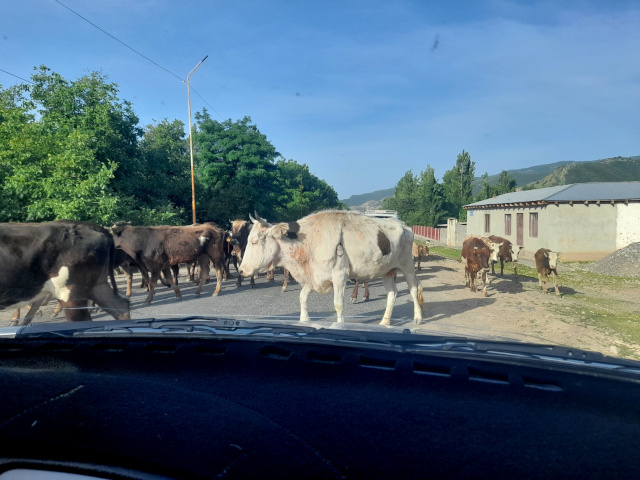
Sometimes slow going on road to Bishkek.
After 1.5 days in Arslanbob, it was a long journey by share-taxi to Bishkek, from 07:00 to 19:00. We drove through some green and some dry country, passing through towns, valleys with towering mountains in the distance, and a couple of nameless mountain passes. The first pass was quite beautiful and panoramic. The second pass was missed, going through a tunnel instead; it was the WORST tunnel I had ever transited, dark, narrow, dingy, dusty, slow and long; positively freaky.
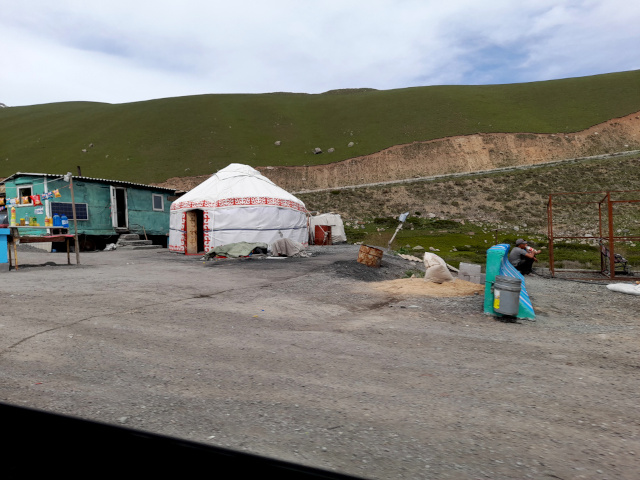
Main residences in rural Kyrgyzstan seem to be yurts and some sort of "shepherd's hut".
In the Kyrgyz capital, Bishkek, in the early evening, we checked in to our pre-booked hostel. It wasn't as salubrious as expected, having to move premises and getting a room that was more like a dorm, but it would be OK for a couple of nights. Getting in late and not many restaurants around, we simply bought a few things from a grocery store for a quick dinner. Next day we were concerned as to how to get from Bishkek back into Kazakhstan and to Almaty. But our hostel host helped us with advice, and we found that buses went there, we were able to get to the Western Bus Station, and get bus tickets directly to Almaty for 08:00 the next day.
Bishkek is a pleasant city, clean and tidy with many parks and green spaces and some monuments and cultural attractions. So, we could spend our last afternoon there exploring parks and monuments. First was a smallish park that had a Zhisup Balasagyn and Shabdan Baatyr monuments (don't ask what all these mean). Then we came to a small square Gorky Park, dominated by a statue of Maxim. Then the large Paniflov Park, with some fun-fair rides etc. and a statue of the General. Then the Memorial of Kyrgyz-Russian friendship, with its towering monument surrounded by statues of people "hanging in the air". Then the National Historical Museum and large Manas Square. This square has the imposing Manas statue on a horse, with a huge Kyrgyz flag in the background and 2 guards and an hourly goose-step "changing of the guard" ceremony. Then the large, pretty, pleasant Oak Park. On the edge of this park, we found the up-scale Seasons Restaurant, where Maggie treated us to a magnificent meal of beer, rum/cokes, quesadilla, pasta carbonara and fries, all for I thing about AUD38; wonderful after our saturation on Stans food.
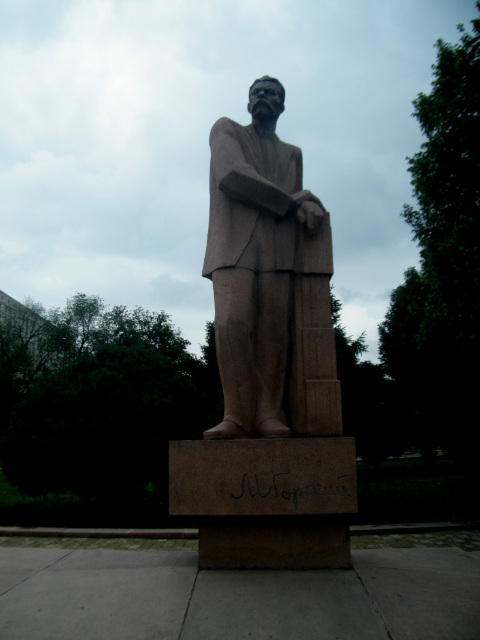
Statue of Maxim Gorky in Gorky Park, Bishkek.
While Kazakhstan is appreciated for its open spaces and modern architecture, Uzbelkistan for cultural/historical significance, Kyrgyzstan has much natural beauty; forests, hills, mountains, farms and roads blocked by domestic animals. It's a gem in its own right.
On 19 May we boarded the bus for Almaty. It was big and comfortable, a pleasant change from the sometimes cramped conditions and uncertainties of the share-taxis. Curiously, among the passengers was a Russian and his family, nomads with no-fixed address; amongst all their luggage the guy had the biggest and heaviest pack I'd ever seen, must have been >40 kg. There were quite a few Russian travellers in the Stans, including a significant number of young guys. I suspect that at least some of them have escaped Russia and are draft dodging to avoid going to Ukraine.
It was about 40 km from Bishkek to the Kazakh border, arriving 09:45. A longish walk with our gear through problem-free exit and entry, and we were back in Kazakhstan, on a nice ride again through Kazakh rolling steppes and herds of horses and goats and villages, into Almaty Sayran bus station before 14:00. We managed a Yandex to our hostel, where we got into a windowless but nice room for 3 nights for the remainder of our stay in Almaty, and in Central Asia.
With only a couple of days before departure, and having seen most of what Almaty had to offer, we took it easy most of the time, packed/prepared to leave, and frequented a nearby shopping mall for some meals and looking around. I walked over to the Green Bazaar for a final look at the market, and another short walk through some of the nearby parkland.
We left our room late on 21 May for our early-morning flight on 22 May. It seems almost all flights, at least ours, are in and out of Almaty airport at night, making me wonder if the place closes down during the day. Our flights took us via Frankfurt and Montreal to Winnipeg, long but fairly routine, except that the plane arrived late in Montreal, with a loooong run from one end of the airport to the other, through passport control, barely making our connecting flight to Winnipeg. We were back home mid-afternoon on 22 May, to unwind and meet the family.
We'd been 6 weeks in Central Asia. It had been quite intense and at times tiring and difficult, and Maggie, I think, would not like another trip of that pace. But we saw and accomplished a lot, it was well worth it, and I'm (we're?) glad we went.
